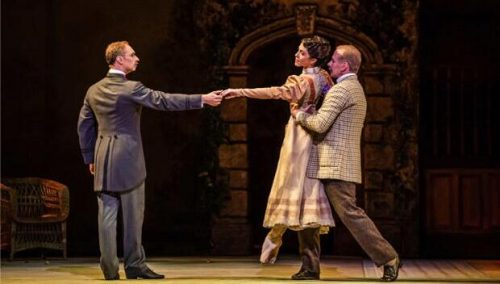 United Kingdom The Royal Ballet – Enigma Variations: Dancers of The Royal Ballet, Orchestra of the Royal Opera House / Pavel Sorokin (conductor). Filmed on 5.11.2019 (directed for the screen by Ross MacGibbon). (JO’D)
United Kingdom The Royal Ballet – Enigma Variations: Dancers of The Royal Ballet, Orchestra of the Royal Opera House / Pavel Sorokin (conductor). Filmed on 5.11.2019 (directed for the screen by Ross MacGibbon). (JO’D)

and Christopher Saunders (Edward Elgar) © Tristram Kenton
Production:
Music – Edward Elgar
Choreography – Frederick Ashton
Designs – Julia Trevelyan Oman
Lighting design – John B. Read
Staging – Kevin O’Hare & Christopher Saunders
Cast included:
The Lady Elgar – Laura Morera
Edward Elgar – Christopher Saunders
A.J. Jaeger (Nimrod) – Bennet Gartside
Dora Penny (Dorabella) – Francesca Hayward
Arthur Troyte Griffith (Troyte) – Matthew Ball
Lady Mary Lygon – Itziar Mendizabal Production
‘Enigma Variations is a hard ballet to revive,’ writes Zoë Anderson in The Royal Ballet 75 Years. It’s a hard ballet to write about, too, after a performance viewed on a laptop screen. The telling theatrical details that choreographer Frederick Ashton includes at the side of the stage and in the background are often lost for the sake of close-ups on the dancers in the centre.
On a second or third viewing, which the ballet repays, some of the details become clear. As a young couple dance a love duet in the garden of his country house, the much older Edward Elgar looks on. He takes a watch from his pocket. Along with the few brown leaves that fall around the couple when they finish their dance, it is a reminder that for young people, too, time passes.
Created in 1968, at a time when Frederick Ashton was at a crisis in his own career, the autumnal, ‘elegiac’ Enigma Variations presents Elgar (Christopher Saunders) in a situation of doubt. Although surrounded by his wife (Laura Morera) and his friends, he is the lonely and uncertain artist. The variations of the music’s title, and the ballet’s, relate to the different personalities of the composer’s circle and their character traits as he perceives them.
With their ear trumpets, their bicycles, their layers of Edwardian tweed, the men form an often-eccentric collection of individuals. The women’s movements are less jerky. They dance to the music’s more flowing sections. If Ashton is looking back to his own Edwardian childhood, much of what the women do is what Isadora Duncan and Anna Pavlova did. Significantly, it is a woman (Itziar Mendizabal as a Loie Fuller-like Lady Mary Lygon) who heralds the climax of the ballet: the arrival of a telegram.
Men, women; youth, age: the ballet is built around these contrasts. At its centre is the trio of the composer, his wife, and his friend Augustus Jaeger (Bennet Gartside). Their dance is similar to that of The Young Man, The Gypsy Girl and Her Lover in Ashton’s The Two Pigeons, to Sylvia’s dance with Orion’s two attendants in Sylvia, to the three figures of Monotones II: a woman serving as a link between two men.
The arrival of the telegram, with its news of recognition for Elgar’s music, is a strictly men-only affair. Not until the congratulatory hand-shaking and patting of tweed-clad backs is complete do the main female characters (with the exception of Lady Elgar) waft in on pointe like a symbolic corps of Snowflakes, or Wilis, or Shades.
The ballet ends on a note of resolution. Not only of the relationship between Elgar and his work, Elgar and his wife, but also of that between all the characters. Starting out as individuals spread around the stage, they finish as a group in which each one finds and has a place.
The atmosphere of Enigma Variations may, as Zoë Anderson states, ‘be difficult to pin down’. On repeated viewings, though, the words of the American dance critic Edwin Denby seem equally relevant: ‘The more limited the subject, the deeper and more beautiful is Ashton’s poetic view of it.’
John O’Dwyer

I absolutely LOVE this Ballet…I remember seeing the original cast many years ago and being blown away by the ‘acting’ just as much as the dancing. I know have it on DVD and often show it to friends. It never ceases to resonate with me…especially Nimrod, the most amazing thing here is what the dancers do at the climax…No histrionics of balletic steps but the way they run to the front of the stage…pause, turn and then walk to the back. I cry every time I see it. All the dancers are just wonderful but I especially like Christopher Saunders as Elgar having watched him coaching this new generation in rehearsal, which is fascinating…(Wayne sleep too!!)